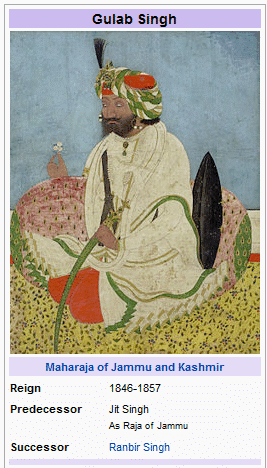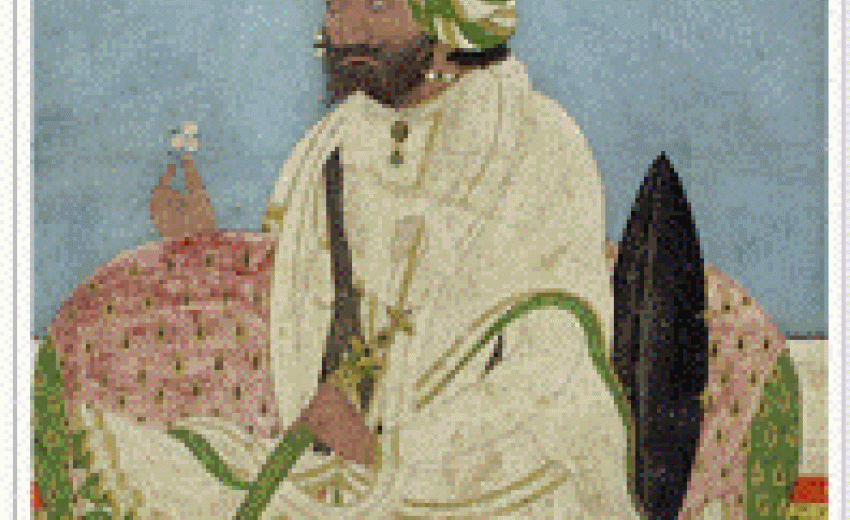March 16 is the darkest day in the history of Kashmir. It was on that day in 1846 when one of the most inhuman treaties of the human history was concluded through which the entire human population of Kashmir was sold by a trading company of 'the country of shopkeepers' to a 'rascal', as the managers of that company called him. The treaty, which is the root cause for most of the sufferings of Kashmiris, is the Treaty of Amritsar. The inhuman Treaty inflicted a deep wound on the Kashmiris mass psyche which refuses to heal, even after the lapse of more than one and a half century time period.
 Source |
The Treaty of Lahore made the Sikh State a British tributary and imposed on it an indemnity of rupees one and half crore which Governor-General, Hardinge, was clearly aware that the Sikhs would be unable to pay. Since it could not pay, it ceded the territories between Beas and Indus rivers including Kashmir and Hazara. The Article XII of the Treaty was inserted to prepare ground for the Treaty of Amritsar and describe Gulab Singh's treachery to his masters with exquisite delicacy: "In consideration of the services rendered by Raja Golab Singh of Jummoo to the Lahore State, towards procuring the restoration of the elations of amity between the Lahore and British Governments, the Maharaja hereby agrees to recognize the Independent Sovereignty of Raja Golab Singh, in such territories and districts in the hills as may be made over to the said Raja Golab Singh by separate Agreement between himself and the British Government…" That separate agreement was the Treaty of Amritsar, signed only after a week, through which the British transferred the territories ceded from the Sikh state to the Gulab Singh for Rs 75 lakhs with British occupying Kalu and Manali. Thus, came into existence the state of Jammu and Kashmir formed through inheritance, conquest, purchase and the British blessings. Later on some other small but distinct political entities were added to the State. The most significant was the Gilgit Agency, which the British attached to the State for political convenience in 1889, and which the Dogras leased back to them in 1935. Also Poonch came under the formal control of the State in 1936. Thus a group of otherwise unrelated tracts were converted to form a Princely State, which had nothing in common except a ruler imposed on it, purely for political considerations.
Without going into the details of the motives behind the Treaty of Amritsar, and the subsequent carving out of a new princely state under Gulab Singh, suffice to say that the "creation of the State of Jammu and Kashmir in 1846 flowed from the geo-political and strategic considerations of the East India Company in the critical North-Western frontier of its expanding Indian dominion", than merely "rewarding….Gulab Singh's treachery to the Lahore State". Although, Hardinge rated Gulab Singh as 'a rascal', he found in him sufficient ability to act as a buffer between British Indian territories and the threatening bear- Czarist Russia- thus, relieving the Company from the compulsion of undertaking the expansive defense of the crucial north-western frontier on its own.
The imposition of the Dogra dynasty of Jammu on the people of Kashmir Valley, with predominant Muslim population, by the British, was negatively unique phenomena for them mainly for three reasons. Firstly, although, the people of the Valley had been continuously ruled, since the Mughal occupation in 1586, by the dynasts who had their centers of power outside the Kashmir, however, they (at least some sections) were always involved, in one way or the other, in the process of change, either by way of sending invitations or serving as local collaborators to the occupying forces. But in the case of the Dogra occupation, all new arrangements were made without their knowledge and least with their consent.
Secondly, Dogra dynasty, with its base at Jammu, was unlike its Mughal, Afghan and Sikh predecessors, ruling from a culturally less known region than the Valley, which had a very rich cultural past and civilizational background. It may be for this reason that Dogras consciously imposed on Kashmiris the inhuman practices (like, begar, organized prostitution and unarmed them to reduce their marshal sprit, to mention only a few) to dehumanize them and to reduce their cultural level.
Thirdly, unlike their predecessors, Dogras were not sovereigns in the strict sense of the term, rather they were vassals of the another mightier power- British colonialists- as is clear from the Article X of the Treaty of Amritsar. Thus the people of the Valley were supposed to show their allegiance to two masters- the Dogras and the British. It was double imperialism.
The Treaty of Amritsar was, by all standards, a sale deed- albeit concluded under the shadow of politics and to serve purely the political interests of the parties concerned. Justice A S Anand, a legal luminary and formerly the Chief Justice of India, in his seminal treatise on the constitutional history of Jammu and Kashmir, concludes after thoroughly cross examining the arguments regarding the nature of the Treaty: "when you accept money in consideration for a transfer of a material thing, the transaction is nothing but 'sale'. Dr Mohammed Iqbal, the philosopher-poet, who was of Kashmiri descent and the early mentor of the nationalist leadership of Kashmir, while expressing the grief on the Treaty, through the mouth of a renowned Persian poet of Kashmir, Ganni Kashmiri, wrote the following: Their fields, their crops, their streams/Even the peasants in the Vale/ They sold all/ Alas, how cheap was the sale.
Also the famous Urdu poet, Hafiz Jallendhuri, whose poems were frequently quoted and which moved the sprits of the Kashmiri people during the national movement, wrote an elegy, lamenting the Treaty, which reads: The fate of Human beings was sold for Rs seventy-five lakhs/ Kashmir's paradise was sold for Rs seventy-five lakhs
Kashmiris were lacking both, the leadership as well as the means to resist the imposition of the Treaty, but they were not lacking the desire. Thus, when last Sikh Governor to Kashmir, Sheikh Immamudin refused to submit, Kashmiris threw their lot behind him which sustained his revolt against the combined Dogra-British-Sikh forces for months together. Captain Arthur Broome, who was deputed to oversee the transfer of power to Gulab Singh, Confirmed Sheikh Immamudin's impressively wide base of support in Kashmir and suggested that he had "the chief power in the country and the popular feeling…..[was] with him." Thus Immamudin, with popular support to his side and rich resources of the Valley at his disposal, managed to inflict a crushing defeat to the Dogra army and Gulab Singh's representative, Lakhpat Rai was killed. The Treaty was enforced by the British arms. It was only when British troops along with Sikh forces marched to the Valley that Immamudin surrendered and the Gulab Singh was installed as the new ruler. It may not look surprising then that a century later, in 1946, Sheikh Mohammad Abdullah proudly recalled Immamudin's revolt in the court where he was tried for sedition charges for launching the Quit Kashmir movement which challenged the very basis of the Treaty and, hence, the moral right if the Dogras to rule over Kashmir.
Dogra's tried to legitimize their rule on the strength of the British might and their Hindu-ness and pushed entire Muslim population in the Valley into a position of exclusion and disadvantage in almost all spheres of political, social and economic life. Even their British masters felt ashamed. Colonel Ralph Young visited Kashmir in 1867. As he travelled along the road to Srinagar, he found "that it had all been once under cultivation but it is now desolate. Certainly the country is not now flourishing". However, more accurate and outspoken was a real humanist, Robert Thorp. He openly held British responsible to "the people whom it sold into the slavery of Gulab Singh". He described Kashmiris "whose characteristics (both intellectual and moral) give evidence of former greatness, trampled upon by a race in every way inferior to themselves and steadily themselves and bars the way to all improvement, whether social, intellectual or religious".
Dogra regime, having tasted a crushing defeat at the very outset, made it a point to crush the virility of the descendents of Lalitadetya and Sultan Shihabudin. Not only were they literally unarmed and banned from joining army, but even mimic fighting solely for the purpose of entertainment was strictly prohibited. Jawaharlal Nehru was aware of all this as he arranged the defense of Sheikh Abdullah along with Asif Ali in a sedition case for launching Quit Kashmir Movement, but out of political arrogance, he wrote to a proud Abdullah on August 25, 1952, that Kashmiris are "not what are called a virile people. They are soft and addicted to easy living".
Tale piece: Neither the Congress's Quit India resolution nor the Muslim League's Pakistan resolution forms part of the lore of Kashmir's freedom movement. The two events which stir a Kashmiri are Martyr's Day of July 13 and Quit Kashmir, the roots of both lie in the Treaty of Amritsar. It needs open mindedness and some sense of past to understand that.
Author is Assistant Professor in History.
-Kashmir Times-
-----------------------
About the treaty:
Treaty of Amritsar
From Wikipedia, the free encyclopedia
Source
The Treaty of Amritsar, signed on March 16, 1846, marked the sale of Kashmir by the British East India Company to Maharaja Gulab Singh Dogra after the First Sikh War with the United Kingdom. By Article 1 of the treaty, Gulab Singh acquired "all the hilly or mountainous country with its dependencies situated to the eastward of the River Indus and the westward of the River Ravi including Chamba and excluding Lahul, being part of the territories ceded to the British Government by the Lahore State according to the provisions of Article IV of the Treaty of Lahore, dated 9th March, 1846." Under Article 3, Gulab Singh was to pay 75 lakhs (7.5 million) of Nanak Shahi rupees (the ruling currency of Punjab) to the British Government, along with other annual tributes. The Treaty of Amritsar marked the beginning of Dogra rule in Kashmir, which was to end in 1948 after an attack by the Pakistani army which led to Indo-Pakistani War of 1947.

